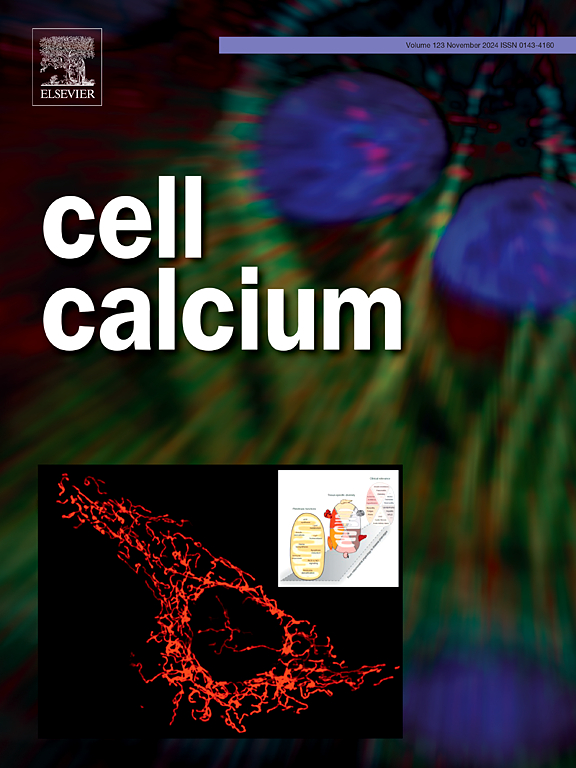棕榈酰化对K+依赖性Na+/Ca2+交换器亚型4 (NCKX4)的调控
IF 4
2区 生物学
Q2 CELL BIOLOGY
引用次数: 0
摘要
哺乳动物K+依赖性Na+/Ca2+交换器(NCKX)由SLC24基因家族编码,对维持Ca2+稳态至关重要。NCKX4广泛表达于脑和感觉神经元,在神经元饱腹感和牙釉质形成中起关键作用。尽管它很重要,但NCKX4的调控机制在很大程度上仍未被探索。本研究探讨了影响膜蛋白的翻译后修饰棕榈酰化(palmitoylation)如何调控NCKX4并影响其细胞定位和功能。使用酰基rac和棕榈酸盐为基础的点击化学,我们发现大约14%的NCKX4在内源性和转染系统中处于稳态棕榈酰化。这种修饰的水平是高度动态的,受棕榈酰化(2-溴铝酸酯)和去棕榈酰化(棕榈抑素B)抑制剂的调节,分别导致大于两倍的减少或增加。6个半胱氨酸残基的定点突变揭示了NCKX4棕榈酰化的两个关键位点(Cys118和Cys425)。通过近端结扎和点击化学检测棕榈酰化NCKX4的亚细胞分布。NCKX4跨越多个膜区室,当2-溴铝酸盐抑制棕榈酰化时,NCKX4在质膜上的定位比例更高。然而,HEK293T细胞中的Ca2+成像分析显示,在棕榈酰化状态的调节下,聚集细胞nckx4介导的Ca2+运输没有显著变化。这些数据表明,棕榈酰化促进了NCKX4蛋白的内化,同时也激活了它,抵消了NCKX4介导的细胞Ca2+运输活性不变的影响。总之,NCKX4受动态棕榈酰化的影响,这影响了细胞间室的分布和内在的Ca2+运输活性。这些发现有助于我们理解NCKX4在细胞生理学中的调控和功能作用。本文章由计算机程序翻译,如有差异,请以英文原文为准。

Regulation of K+-dependent Na+/Ca2+-exchanger subtype 4, NCKX4, by palmitoylation
Mammalian K+-dependent Na+/Ca2+ exchangers (NCKX), encoded by the SLC24 gene family, are crucial for maintaining Ca2+ homeostasis. NCKX4, widely expressed in the brain and sensory neurons, plays a key role in neuronal satiety and enamel formation. Despite its importance, the regulatory mechanisms of NCKX4 remain largely unexplored. This study investigates how palmitoylation, a post-translational modification affecting membrane proteins, regulates NCKX4 and influences its cellular localization and function.
Using Acyl-RAC and palmitate-based click-chemistry, we found that approximately 14% of NCKX4 is palmitoylated at steady-state in both endogenous and transfected systems. The level of this modification is highly dynamic, being regulated by inhibitors of palmitoylation (2-bromopalmitate) and depalmitoylation (palmostatin B), resulting in greater than a two-fold decrease or increase, respectively. Site-directed mutagenesis of six cysteine residues revealed two key sites (Cys118 and Cys425) critical for NCKX4 palmitoylation.
The subcellular distribution of palmitoylated NCKX4 was examined via proximity ligation and click-chemistry. NCKX4 was found across multiple membrane compartments, with a higher fraction localizing to the plasma membrane when palmitoylation was inhibited by 2-bromopalmitate. However, a Ca2+ imaging assay in HEK293T cells showed no significant change in aggregate cellular NCKX4-mediated Ca2+ transport upon modulation of palmitoylation status. These data suggest palmitoylation promotes internalization of the NCKX4 protein while also activating it, counter-acting effects that result in unchanged NCKX4-mediated cellular Ca2+ transport activity.
In summary, NCKX4 is subject to dynamic palmitoylation, which influences both distribution across cellular compartments and intrinsic Ca2+ transport activity. These findings contribute to our understanding of the regulation and functional roles of NCKX4 in cellular physiology.
求助全文
通过发布文献求助,成功后即可免费获取论文全文。
去求助
来源期刊

Cell calcium
生物-细胞生物学
CiteScore
8.70
自引率
5.00%
发文量
115
审稿时长
35 days
期刊介绍:
Cell Calcium covers the field of calcium metabolism and signalling in living systems, from aspects including inorganic chemistry, physiology, molecular biology and pathology. Topic themes include:
Roles of calcium in regulating cellular events such as apoptosis, necrosis and organelle remodelling
Influence of calcium regulation in affecting health and disease outcomes
 求助内容:
求助内容: 应助结果提醒方式:
应助结果提醒方式:


